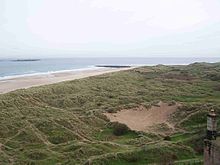55:
36:
274:
270:, Northumberland County Council and Bamburgh Parish Council have come up with a plan of management which has resulted in cattle being allowed to graze the dunes since 2000 to break up the dominant grass cover. A fence has been erected to contain the cattle within the dunes. Access by people is encouraged within the fenced area with stiles and gates sited on the main paths.
62:
261:
Over the years more vigorous invasive plant species and scrub have encroached, making the dune system too stabilised and threatening the uniqueness of
Bamburgh Dunes, as most rare plant species appreciate the unstable and shifting structure of sand dunes. In an effort to counteract this, Bamburgh
285:
7th century burial ground was unearthed in the dunes to the southeast of
Bamburgh Castle during an archaeological dig in 1998 by the Bamburgh Research Project. The burial ground, called the Bowl Hole, had been known to exist since 1816 when violent storms removed large amounts of dune sand and
326:
341:
78:
204:, to more stable grass-covered dunes. These occur as a series of irregular parallel sand ridges and hummocks separated by hollows, which are seasonally wet. Some of the plant species include the
197:(SAC). The dunes have a rich diversity of flora and fauna and in places provide good examples of “climbing dunes” found where sand has been blown onto high ground adjacent to the beach.
267:
215:
331:
54:
94:
218:). The dunes are also rich in rare insect life. Over 500 species have been identified, with 15 rare species that include a plant hopper (
109:
190:
27:
306:
346:
194:
102:
159:
336:
311:
231:
201:
291:
239:
351:
149:
294:” became involved during the dig and screened a programme about the finds in February 2001.
205:
35:
251:
186:
41:
263:
182:
88:
320:
235:
282:
247:
243:
273:
255:
210:
200:
Bamburgh Dunes vary from open sandy beaches, through low ridges dominated by
124:
111:
178:
272:
185:, England. The dunes, which stand in the shadow of the impressive
193:(SSSI) since 1995 and are part of the North Northumberland Dunes
177:
with an area of over 40 hectares situated around the village of
174:
171:
287:
327:
Sites of
Special Scientific Interest in Northumberland
342:
Sites of
Special Scientific Interest notified in 1995
148:
140:
101:
87:
77:
216:List of endangered species in the British Isles
214:, sea sandwort and petalwort (which is on the
40:The southern area of Bamburgh Dunes seen from
8:
21:
34:
20:
307:Bamburgh Research Project, Bowl Hole dig.
303:Bamburgh Dunes information board at site.
230:). Birds attracted to the dunes include
61:
332:Tourist attractions in Northumberland
312:English Nature page on Bamburgh Dunes
286:uncovered the site for a period. The
7:
277:Bamburgh Dunes seen from the beach.
191:Site of Special Scientific Interest
28:Site of Special Scientific Interest
14:
60:
53:
69:Location within Northumberland
1:
195:Special Area of Conservation
368:
144:44.64 hectares (110 acres)
158:
48:
33:
26:
170:are a region of coastal
222:), a grass-mining fly (
220:Dicranotropis divergens
160:Natural England website
290:television programme “
278:
276:
347:Northumberland coast
226:), and a shore fly (
232:grasshopper warbler
121: /
23:
292:Meet the Ancestors
279:
240:European stonechat
228:Psilopa marginella
165:
164:
359:
337:Dunes of England
258:are also found.
224:Opomyza punctata
206:pyramidal orchid
154:28 February 1995
136:
135:
133:
132:
131:
126:
125:55.608°N 1.703°W
122:
119:
118:
117:
114:
97:
64:
63:
57:
38:
24:
367:
366:
362:
361:
360:
358:
357:
356:
317:
316:
300:
262:Castle Estate,
252:short-eared owl
187:Bamburgh Castle
129:
127:
123:
120:
115:
112:
110:
108:
107:
93:
73:
72:
71:
70:
67:
66:
65:
44:
42:Bamburgh Castle
17:
16:Region of dunes
12:
11:
5:
365:
363:
355:
354:
349:
344:
339:
334:
329:
319:
318:
315:
314:
309:
304:
299:
296:
264:English Nature
189:, have been a
183:Northumberland
168:Bamburgh Dunes
163:
162:
156:
155:
152:
146:
145:
142:
138:
137:
130:55.608; -1.703
105:
99:
98:
91:
89:Grid reference
85:
84:
83:Northumberland
81:
75:
74:
68:
59:
58:
52:
51:
50:
49:
46:
45:
39:
31:
30:
22:Bamburgh Dunes
15:
13:
10:
9:
6:
4:
3:
2:
364:
353:
350:
348:
345:
343:
340:
338:
335:
333:
330:
328:
325:
324:
322:
313:
310:
308:
305:
302:
301:
297:
295:
293:
289:
284:
275:
271:
269:
265:
259:
257:
253:
250:. In winter,
249:
245:
241:
237:
236:sedge warbler
233:
229:
225:
221:
217:
213:
212:
207:
203:
198:
196:
192:
188:
184:
180:
176:
173:
169:
161:
157:
153:
151:
147:
143:
139:
134:
106:
104:
100:
96:
92:
90:
86:
82:
80:
76:
56:
47:
43:
37:
32:
29:
25:
19:
280:
260:
248:reed bunting
244:meadow pipit
227:
223:
219:
209:
202:marram grass
199:
167:
166:
150:Notification
18:
283:Anglo-Saxon
281:An ancient
128: /
103:Coordinates
321:Categories
298:References
256:water rail
211:Centaurium
113:55°36′29″N
116:1°42′11″W
352:Bamburgh
179:Bamburgh
95:NU188350
79:Location
268:DEFRA
175:dunes
254:and
246:and
172:sand
141:Area
288:BBC
181:in
323::
266:,
242:,
238:,
234:,
208:,
Text is available under the Creative Commons Attribution-ShareAlike License. Additional terms may apply.

